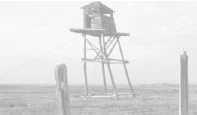Gulag (5 page)

Within the camps, the process of dehumanization deepened and grew more extreme, helping both to intimidate the victims and to reinforce the victimizers’ belief in the legitimacy of what they were doing. In her book-length interview with Franz Stangl, the commander of Treblinka, the writer Gitta Sereny asked Stangl why camp inmates, before being killed, were also beaten, humiliated, and deprived of their clothing. Stangl answered, “To condition those who actually had to carry out the policies. To make it possible for them to do what they did.”
54
In The Order of Terror: The
Concentration Camp
, the German sociologist Wolfgang Sofsky has also shown how the dehumanization of prisoners in the Nazi camps was methodically built into every aspect of camp life, from the torn, identical clothing, to the deprivation of privacy, to the heavy regulation, to the constant expectation of death.
In the Soviet system, the dehumanization process also began at the moment of arrest, as we shall see, when prisoners were stripped of their clothes and identity, denied contact with outsiders, tortured, interrogated, and put through farcical trials, if they were tried at all. In a peculiarly Soviet twist on the process, prisoners were deliberately “excommunicated” from Soviet life, forbidden to refer to one another as “comrade,” and, from 1937 on, prohibited from earning the coveted title of “shock-worker,” no matter how well they behaved or how hard they worked. Portraits of Stalin, which hung in homes and offices throughout the USSR, almost never appeared inside camps and prisons, according to many prisoner accounts.
None of which is to say that the Soviet and Nazi camps were identical. As any reader with any general knowledge of the Holocaust will discover in the course of this book, life within the Soviet camp system differed in many ways, both subtle and obvious, from life within the Nazi camp system. There were differences in the organization of daily life and of work, different sorts of guards and punishments, different kinds of propaganda. The Gulag lasted far longer, and went through cycles of relative cruelty and relative humanity. The history of the Nazi camps is shorter, and contains less variation: they simply became crueler and crueler, until the retreating Germans liquidated them or the invading Allies liberated them. The Gulag also contained a wide variety of camps, from the lethal gold mines of the Kolyma region to the “luxurious” secret institutes outside Moscow, where prisoner scientists designed weapons for the Red Army. Although there were different kinds of camps in the Nazi system, the range was far narrower.
Above all, however, two differences between the systems strike me as fundamental. First, the definition of “enemy” in the Soviet Union was always far more slippery than the definition of “Jew” in Nazi Germany. With an extremely small number of unusual exceptions, no Jew in Nazi Germany could change his status, no Jew inside a camp could reasonably expect to escape death, and all Jews carried this knowledge with them at all times. While millions of Soviet prisoners feared they might die—and millions did—there was no single category of prisoner whose death was absolutely guaranteed. At times, certain prisoners could improve their lot by working in relatively comfortable jobs, as engineers or geologists. Within each camp there was a prisoner hierarchy, which some were able to climb at the expense of others, or with the help of others. At other times—when the Gulag found itself overburdened with women, children, and old people, or when soldiers were needed to fight at the front—prisoners were released in mass amnesties. It sometimes happened that whole categories of “enemies” suddenly benefited from a change in status. Stalin arrested hundreds of thousands of Poles, for example, at the start of the Second World War in 1939—and then abruptly released them from the Gulag in 1941 when Poland and the USSR became temporary allies. The opposite was also true: in the Soviet Union, perpetrators could become victims themselves. Gulag guards, administrators, even senior officers of the secret police, could also be arrested and find themselves sentenced to camps. Not every “poisonous weed” remained poisonous, in other words—and there was no single group of Soviet prisoners who lived with the constant expectation of death.
55
Second—as, again, will become evident in the course of this book—the primary purpose of the Gulag, according to both the private language and the public propaganda of those who founded it, was economic. This did not mean that it was humane. Within the system, prisoners were treated as cattle, or rather as lumps of iron ore. Guards shuttled them around at will, loading and unloading them into cattle cars, weighing and measuring them, feeding them if it seemed they might be useful, starving them if they were not. They were, to use Marxist language, exploited, reified, and commodified. Unless they were productive, their lives were worthless to their masters.
Nevertheless, their experience was quite different from that of the Jewish and other prisoners whom the Nazis sent to a special group of camps called not
Konzentrationslager
but
Vernichtungslager—
camps that were not really “labor camps” at all, but rather death factories. There were four of them: Belzec, Chelmno, Sobibor, and Treblinka. Majdanek and Auschwitz contained both labor camps and death camps. Upon entering these camps, prisoners were “selected.” A tiny number were sent to do a few weeks of forced labor. The rest were sent directly into gas chambers where they were murdered and then immediately cremated.
As far as I have been able to ascertain, this particular form of murder, practiced at the height of the Holocaust, had no Soviet equivalent. True, the Soviet Union found other ways to mass-murder hundreds of thousands of its citizens. Usually, they were driven to a forest at night, lined up, shot in the skull, and buried in mass graves before they ever got near a concentration camp—a form of murder no less “industrialized” and anonymous than that used by the Nazis. For that matter, there are stories of Soviet secret police using exhaust fumes—a primitive form of gas—to kill prisoners, just as the Nazis did in their early years.
56
Within the Gulag, Soviet prisoners also died, usually not thanks to the captors’ efficiency but due to gross inefficiency and neglect.
57
In certain Soviet camps, at certain times, death was virtually guaranteed for those selected to cut trees in the winter forest or to work in the worst of the Kolyma gold mines. Prisoners were also locked in punishment cells until they died of cold and starvation, left untreated in unheated hospitals, or simply shot at will for “attempted escape.” Nevertheless, the Soviet camp system as a whole was not deliberately organized to mass-produce corpses—even if, at times, it did.
These are fine distinctions, but they matter. Although the Gulag and Auschwitz do belong to the same intellectual and historical tradition, they are nevertheless separate and distinct, both from one another and from camp systems set up by other regimes. The idea of the concentration camp may be general enough to be used in many different cultures and situations, but even a superficial study of the concentration camp’s cross-cultural history reveals that the specific details—how life in the camps was organized, how the camps developed over time, how rigid or disorganized they became, how cruel or liberal they remained—depended on the particular country, on the culture, and on the regime.
58
To those who were trapped behind barbed wire, these details were critical to their life, health, and survival.
In fact, reading the accounts of those who survived both, one is struck more by the differences between the victims’ experiences than by the differences between the two camp systems. Each tale has its own unique qualities, each camp held different sorts of horrors for people of different characters. In Germany you could die of cruelty, in Russia you could die of despair. In Auschwitz you could die in a gas chamber, in Kolyma you could freeze to death in the snow. You could die in a German forest or a Siberian waste-land, you could die in a mining accident or you could die in a cattle train. But in the end, the story of your life was your own.
PART ONE
THE ORIGINS OF THE GULAG, 1917—1939
Chapter 1
BOLSHEVIK BEGINNINGS

But your spine has been smashed,
My beautiful, pitiful era,
And with an inane smile
You look back, cruel and weak,
Like an animal past its prime,
At the prints of your own paws.
—Osip Mandelstam, “Vek”
1
One of my goals is to destroy the myth that the cruelest era of
repression began in 1936–37. I think that in future, statistics
will show that the wave of arrests, sentences and exile had
already begun at the beginning of 1918, even before the
official declaration, that autumn, of the “Red Terror.” From
that moment, the wave simply grew larger and larger, until
the death of Stalin . . .
—Dmitri Likhachev, Vospominaniya
2
IN THE YEAR 1917, two waves of revolution rolled across Russia, sweeping Imperial Russian society aside as if it were destroying so many houses of cards. After Czar Nicholas II abdicated in February, events proved extremely difficult for anyone to halt or control. Alexander Kerensky, the leader of the first post-revolutionary Provisional Government, later wrote that, in the void following the collapse of the old regime, “all existing political and tactical programs, however bold and well conceived, appeared hanging aimlessly and uselessly in space.”
3
But although the Provisional Government was weak, although popular dissatisfaction was widespread, although anger at the carnage caused by the First World War ran high, few expected power to fall into the hands of the Bolsheviks, one of several radical socialist parties agitating for even more rapid change. Abroad, the Bolsheviks were scarcely known. One apocryphal tale illustrates foreign attitudes very well: in 1917, so the story goes, a bureaucrat rushed into the office of the Austrian Foreign Minister, shouting, “Your Excellency, there has been a revolution in Russia!” The minister snorted. “Who could make a revolution in Russia? Surely not harmless Herr Trotsky, down at the Café Central?”
If the nature of the Bolsheviks was mysterious, their leader, Vladimir Ilyich Ulyanov—the man the world would come to know by his revolutionary pseudonym, “Lenin”—was even more so. During his many years as an émigré revolutionary, Lenin had been recognized for his brilliance, but also disliked for his intemperance and his factionalism. He picked frequent fights with other socialist leaders, and had a penchant for turning minor disagreements over seemingly irrelevant matters of dogma into major arguments.
4
In the first months following the February Revolution, Lenin was very far from holding a position of unchallenged authority, even within his own Party. As late as mid-October 1917, a handful of leading Bolsheviks continued to oppose his plan to carry out a coup d’état against the Provisional Government, arguing that the Party was unprepared to take power, and that it did not yet have popular support. He won the argument, however, and on October 25 the coup took place. Under the influence of Lenin’s agitation, a mob sacked the Winter Palace. The Bolsheviks arrested the ministers of the Provisional Government. Within hours, Lenin had become the leader of the country he renamed Soviet Russia.
Yet although Lenin had succeeded in taking power, his Bolshevik critics had not been entirely wrong. The Bolsheviks were indeed wildly unprepared. As a result, most of their early decisions, including the creation of the one-party state, were taken to suit the needs of the moment. Their popular support was indeed weak, and almost immediately they began to wage a bloody civil war, simply in order to stay in power. From 1918, when the White Army of the old regime regrouped to fight the new Red Army—led by Lenin’s comrade, “Herr Trotsky” from the “Café Central”—some of the most brutal fighting ever seen in Europe raged across the Russian countryside. Nor did all of the violence take place in battlefields. The Bolsheviks went out of their way to quash intellectual and political opposition in any form it took, attacking not only the representatives of the old regime but also other socialists: Mensheviks, Anarchists, Social Revolutionaries. The new Soviet state would not know relative peace until 1921.
5
Against this background of improvisation and violence, the first Soviet labor camps were born. Like so many other Bolshevik institutions, they were created ad hoc, in a hurry, as an emergency measure in the heat of the civil war. This is not to say the idea had no prior appeal. Three weeks before the October Revolution, Lenin himself was already sketching out an admittedly vague plan to organize “obligatory work duty” for wealthy capitalists. By January 1918, angered by the depth of the anti-Bolshevik resistance, he was even more vehement, writing that he welcomed “the arrest of millionaire-saboteurs traveling in first- and second-class train compartments. I suggest sentencing them to half a year’s forced labor in a mine.”
6
Lenin’s vision of labor camps as a special form of punishment for a particular sort of bourgeois “enemy” sat well with his other beliefs about crime and criminals. On the one hand, the first Soviet leader felt ambivalent about the jailing and punishment of traditional criminals—thieves, pickpockets, murderers—whom he perceived as potential allies. In his view, the basic cause of “social excess” (meaning crime) was “the exploitation of the masses.” The removal of the cause, he believed, “will lead to the withering away of the excess.” No special punishments were therefore necessary to deter criminals: in time, the Revolution itself would do away with them. Some of the language in the Bolsheviks’ first criminal code would have thus warmed the hearts of the most radical, progressive criminal reformers in the West. Among other things, the code decreed that there was “no such thing as individual guilt,” and that punishment “should not be seen as retribution.”
7
On the other hand, Lenin—like the Bolshevik legal theorists who followed in his wake—also reckoned that the creation of the Soviet state would give rise to a new kind of criminal: the “class enemy.” A class enemy opposed the Revolution, and worked openly, or more often secretly, to destroy it. The class enemy was harder to identify than an ordinary criminal, and much harder to reform. Unlike an ordinary criminal, a class enemy could never be trusted to cooperate with the Soviet regime, and required harsher punishment than would an ordinary murderer or thief. Thus in May 1918, the first Bolshevik “decree on bribery” declared that: “If the person guilty of taking or offering bribes belongs to the propertied classes and is using the bribe to preserve or acquire privileges, linked to property rights, then he should be sentenced to the harshest and most unpleasant forced labor and all of his property should be confiscated.”
8
From the very earliest days of the new Soviet state, in other words, people were to be sentenced not for what they had done, but for who they were.
Unfortunately, nobody ever provided a clear description of what, exactly, a “class enemy” was supposed to look like. As a result, arrests of all sorts increased dramatically in the wake of the Bolshevik coup. From November 1917, revolutionary tribunals, composed of random “supporters” of the Revolution, began convicting random “enemies” of the Revolution. Prison sentences, forced-labor terms, and even capital punishment were arbitrarily meted out to bankers, to merchants’ wives, to “speculators”— meaning anyone engaged in independent economic activity—to former Czarist-era prison warders and to anyone else who seemed suspicious.
9
The definition of who was and who was not an “enemy” also varied from place to place, sometimes overlapping with the definition of “prisoner of war.” Upon occupying a new city, Trotsky’s Red Army frequently took bourgeois hostages, who could be shot in case the White Army returned, as it often did along the fluctuating lines of the front. In the interim they could be made to do forced labor, often digging trenches and building barricades.
10
The distinction between political prisoners and common criminals was equally arbitrary. The uneducated members of the temporary commissions and revolutionary tribunals might, for example, suddenly decide that a man caught riding a tram without a ticket had offended society, and sentence him for political crimes.
11
In the end, many such decisions were left up to the policemen or soldiers doing the arresting. Feliks Dzerzhinsky, founder of the Cheka—Lenin’s secret police, the forerunner of the KGB— personally kept a little black notebook in which he scribbled down the names and addresses of random “enemies” he came across while doing his job.
12
These distinctions would remain vague right up until the collapse of the Soviet Union itself, eighty years later. Nevertheless, the existence of two categories of prisoner—“political” and “criminal”—had a profound effect on the formation of the Soviet penal system. During the first decade of Bolshevik rule, Soviet penitentiaries even split into two categories, one for each type of prisoner. The split arose spontaneously, as a reaction to the chaos of the existing prison system. In the very early days of the Revolution, all prisoners were incarcerated under the jurisdiction of the “traditional” judicial ministries, first the Commissariat of Justice, later the Commissariat of the Interior, and placed in the “ordinary” prison system. That is, they were thrown into the remnants of the Czarist system, usually into the dirty, gloomy stone prisons which occupied a central position in every major town. During the revolutionary years of 1917 to 1920, these institutions were in total disarray. Mobs had stormed the jails, self-appointed commissars had sacked the guards, prisoners had received wide-ranging amnesties or had simply walked away.
13
By the time the Bolsheviks took charge, the few prisons that remained in operation were overcrowded and inadequate. Only weeks after the Revolution, Lenin himself demanded “extreme measures for the immediate improvement of food supplies to the Petrograd prisons.”
14
A few months later, a member of the Moscow Cheka visited the city’s Taganskaya prison and reported “terrible cold and filth,” as well as typhus and hunger. Most of the prisoners could not carry out their forced-labor sentences because they had no clothes. A newspaper report claimed that Butyrka prison in Moscow, designed to hold 1,000 prisoners, already contained 2,500. Another newspaper complained that the Red Guards “unsystematically arrest hundreds of people every day, and then don’t know what to do with them.”
15
Overcrowding led to “creative” solutions. Lacking anything better, the new authorities incarcerated prisoners in basements, attics, empty palaces, and old churches. One survivor later remembered being placed in the cellar of a deserted house, in a single room with fifty people, no furniture, and little food: those who did not get packages from their families simply starved.
16
In December 1917, a Cheka commission discussed the fate of fiftysix assorted prisoners—“thieves, drunks and various ‘politicals’”—who were being kept in the basement of the Smolny Institute, Lenin’s headquarters in Petrograd.
17
Not everyone suffered from the chaotic conditions. Robert Bruce Lockhart, a British diplomat accused of spying (accurately, as it happened), was imprisoned in 1918 in a room in the Kremlin. He occupied himself playing Patience, and reading Thucydides and Carlyle. From time to time, a former imperial servant brought him hot tea and newspapers.
18
But even in the remaining traditional jails, prison regimes were erratic, and prison wardens were inexperienced. A prisoner in the northern Russian–Finnish border city of Vyborg discovered that, in the topsy-turvy post-revolutionary world, his former chauffeur had become a prison guard. The man was delighted to help his former master move to a better, drier cell, and eventually to escape.
19
One White Army colonel also recalled that in the Petrograd prison in December 1917 prisoners came and left at will, while homeless people slept in the cells at night. Looking back on this era, one Soviet official remembered that “the only people who didn’t escape were those who were too lazy.”
20
The disarray forced the Cheka to come up with new solutions: the Bolsheviks could hardly allow their “real” enemies to enter the ordinary prison system. Chaotic jails and lazy guards might be suitable for pickpockets and juvenile delinquents, but for the saboteurs, parasites, speculators, White Army officers, priests, bourgeois capitalists, and others who loomed so large in the Bolshevik imagination, more creative solutions were needed.
A solution was found as early as June 4, 1918, when Trotsky called for a group of unruly Czech war prisoners to be pacified, disarmed, and placed in a
kontslager
: a concentration camp. Twelve days later, in a memorandum addressed to the Soviet government, Trotsky again spoke of concentration camps, outdoor prisons in which “the city and village bourgeoisie . . . shall be mobilized and organized into rear-service battalions to do menial work (cleaning barracks, camps, streets, digging trenches, etc.). Those refusing will be fined, and held under arrest until the fine is paid.”
21




